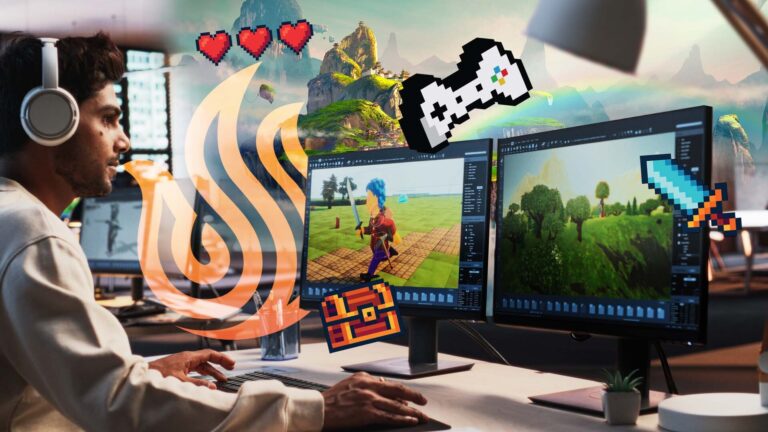Animators use a variety of tools to bring their fantastic worlds to life. One of the main tools used by digital artists the world over is the software known as Blender. This comprehensive animation suite has been used to make popular works throughout the years. From video games, short animations, and even feature length films, Blender can help you make it all. If you desire a career in animation, it is well worth becoming familiar with Blender and similar tools that make digital creation possible.
In addition to Blender, programs such as Houdini, Maya, and After Effects can be used in special circumstances. A huge responsibility of any animator is to learn as many of these programs as possible. Flexibility will get you noticed and open many doors for you within the world of digital entertainment.
What is Blender?
Blender is a popular application for creating both 2D and 3D animated content. The software can be downloaded on Windows, Mac, or Linux. Once installed, you can make animations, rig characters, and create fully 3D scenes on your own accord. Not only can you create art assets for use in your projects, but you can easily import and export your files to other programs as needed. You can think of Blender as a Swiss army knife that all animators keep in their back pocket. It is highly likely your future employers will expect you to know it well. With a bit of practice, you will have the hang of it in no time.
What is Blender Used For?
Primarily, Blender supports each aspect of the animation development pipeline. Since animation projects can last months or even years, the development pipeline keeps everything on track for release. The pipeline is broken up into various steps needed to produce a finished animation. Blender facilitates each step while providing flexibility for artists to leave their mark on the design.
Rigging
To properly animate objects or characters, you must simulate the structure. The most basic example of this is the human body. To make an animated body move in a believable manner, animators rig the character model with a simulation of the human skeletal and muscular systems. Having a realistic rendition of a body’s internal systems allows each body part to move as they should. Since the audience will be acutely familiar with how it looks when people walk, rigging a character’s limbs is required to make an appealing animation.
Animation
The bread and butter of any animated production is the motion applied to each character and object in the scene. Blender allows you to carefully curate and edit animations in real-time. You can make use of traditional keyframe technology, or you can opt for motion capture performances to capture the essence of an actor. Of course, you can even blend the two styles depending on what your project entails.
Simulation
To make an engaging digital world, aspects of life must be simulated in a believable manner. For instance, Blender allows for accurate physics interactions. Objects and characters will react appropriately when a force is applied to them. Other simulation aspects include textures and friction. If a floor appears to be icy, characters and objects should slide along the surface of the ice when moving across it. With a bit of creativity and technical prowess, you can simulate any interaction that audience or players will expect.
Rendering
The last version of each scene looks a bit different than the files that are worked on at a studio. To complete the look of digital scenes, you will apply a process called rendering. This adds in additional effects, bakes in the lighting, and provides a sense of finality to each portion of a project. Blender lets you render scenes directly without the need to export your project to another program like a game engine.
Compositing and Motion Tracking
Creators use mathematical precision to set up a scene exactly as intended. Lining up images and tracking motion involves the use of specific points. Blender lets you set and adjust tracking points to get the perfect camera angle or make quick motions observable on screen. Monitoring the exact coordinates of key points is a hallmark of professional quality work.
Video Editing
Video editing requires some powerful software to perform effectively. While you will likely use several dedicated video editors in addition to Blender, the built-in functionality is great in a pinch. You can make simple edits to animated scenes and add accompanying effects. Music, audio cues, and text can be overlayed as needed. Of course, you are free to export your video files at any time should you require a more substantial program to edit your animation.
Game Creation
It was briefly touched on above that Blender can also help create video games. In fact, many popular titles spanning back to even the PS2 were created with the software. Most studios will use a dedicated game engine like Unreal or Unity, while creating most of their assets in an auxiliary app such as Blender. Since you can easily transfer files between Blender and major game engines, the process is much smoother than it sounds. If numerous legendary games have already been made with Blender, then you can rest assured it will work well with your projects.
How Do You Learn about Animation Software Tools like Blender?
The most efficient way to obtain the skills and knowledge you need is to attend a Bachelor of Arts in Digital Art and Animation degree program at a creative arts college. Not only will you learn about the various tools of the trade, but you will also walk through each step of the animation pipeline. Following this golden path is the key to finishing any digital art project.
You will learn about traditional art in the Digital Art and Animation program. Then you get to apply that knowledge in a digital space. The science of what makes art appealing stays the same regardless of whether you are working with analog or digital tools. With a proper background in art and the animation pipeline, you can work on your own projects with fellow students. The classes are comprised of group projects that can later be reused as portfolio pieces.
What Other Animation and Modeling Software Will You Learn?
A professional animator is versed in a variety of programs and knows exactly which one to employ in any given situation. There are many programs to choose from, and some take a much higher priority than others. While every studio is free to do what they like, industry standards form as people determine what works best. Blender is one of these mainstays and is joined by a few other notable apps. Since your degree program prepares you for many different situations, you will indeed become quite familiar with the following software.
Maya
Autodesk Maya is another popular animation suite. It features many of the same features as Blender, but with a completely distinctive look and feel. Maya also has a stronger emphasis on special effects, so many Hollywood productions prefer it for the extra options it provides. Maya is great for simulating, animating, compositing, and rendering. As you learn more about each, the difference between the two programs will become clearer.
Nuke
Nuke is a powerful 3D animation tool that specializes in post-production processes. You can edit video footage, composite images, and develop intricate VFX. The truly standout feature of Nuke is how customizable it is. Many programs require to adapt your workflow to fit the parameters of the software. However, Nuke is fully customizable. With enough planning, you can make Nuke fit into your existing workflow regardless of how complicated it is. This makes it a favorite at large animation studios that must coordinate hundreds of artists.
zBrush
zBrush is a digital sculpting tool that gives immense levels of control over 3D space. You can create models, textures, and even paint on your creations. By utilizing their proprietary “pixol” technology, zBrush store lighting, materials, colors, and depth information for each point in a scene. Since you can customize any individual pixel on the screen, zBrush is the go-to choice when adding polish and finishing details to your work.
Houdini
You may be wondering how vast environments can be rendered with such exquisite detail. To make the thousands of individual details look uniform, a process known as procedural generation is used. Procedural generation involves the use of AI to generate inconsequential details in the environment. For instance, you can use Houdini to generate hundreds of trees or bushes that all look slightly different. When you need to fill out vast spaces quickly, procedural generation is the ultimate shortcut. While procedural generation can be effectively used in movies and TV backgrounds, the primary use is for video games. Especially in vast open world titles where miles of wilderness must be simulated.
Substance
Adobe Substance is a neat application that allows you to create digital representations of real-world images. You can take photos and scan them into thew software for customization. From there, Substance behaves in a comparable manner to other animation programs. You can designate keyframes, edit video, and add VFX. The modeling interface resembles drawing, so artists who excel at hand-drawing will take to Substance quickly.
After Effects
As the name implies, After Effects allows you to add a variety of special and VFX to your existing work. This also makes it any excellent tool for motion graphics design. Motion graphics are simple animations that make informational resources more memorable. By adding some color, sound, and motion to text, you can convince an audience to pay attention to a critical piece of information. The post-processing tools in Adobe After Effects can be used to make video games, TV shows, movies, infographics, news presentations, and much more.
Want to Learn More?
If your passion is for visual effects, 2D or 3D animation, or concept art for video games or blockbuster films, this is the Digital Arts & Animation degree program for you. Gain the digital arts and animation skills you need to kick off your career in this dynamic and growing industry.
University of Silicon Valley is uniquely poised to offer a meaningful and valuable education for 21st century students. We believe in an education that directly correlates with the work you’ll be doing after you graduate. Interested in learning more? Contact Us today.


